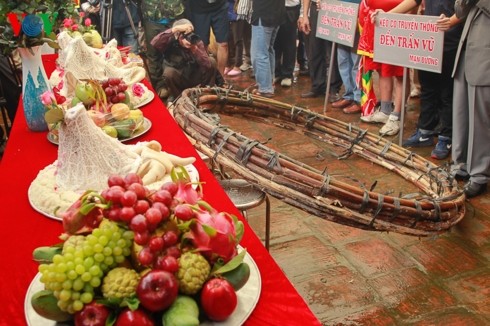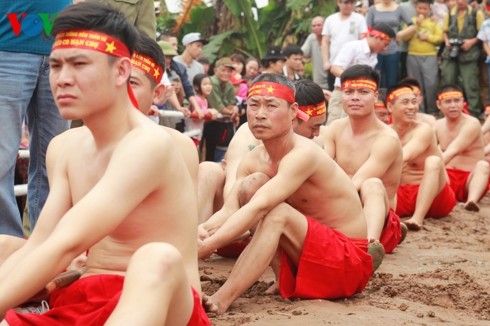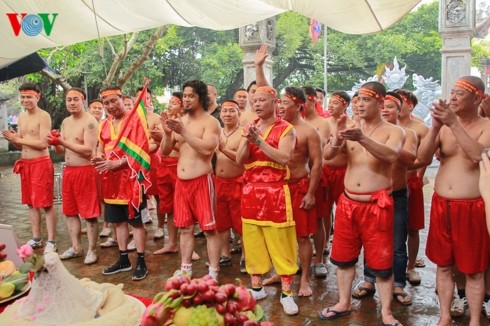 Tug-of-war teams attend a worship ceremony before the games. Tug-of-war teams attend a worship ceremony before the games.
|
Sitting tug-of-war is played on a clay court. Two teams sit on either end of a rope and try to tug it from the other. The rope is passed through a wood pillar planted on the ground between the two teams.
According to legend, a long time ago Ngoc Tri village suffered a severe drought. 11 out of 12 wells in the village were dry. Only one well in Dia hamlet had water. Men from Duong and Cho hamlet went to Dia well to fetch water, but were prevented by Dia hamlet men. Both sides forcibly pulled water buckets and the ropes they used to carry the buckets. Being afraid to spill the water out of the buckets, they sat down to hold the buckets firmly.
 Players sit alternatively, ready for the competition. Players sit alternatively, ready for the competition.
|
When everything was back to normal, villagers remembered the hard time by performing sitting tug-of-war at the village’s festival. Criteria for the players are those whose families have up to 5 generations living in Ngoc Tri village. After a ritual at Tran Vu temple, three teams from Duong, Dia, and Cho hamlet join the competition.
Ngo Quang Khai, Head of the Management Board of Tran Vu Temple, said: “Every year, the organizers will decide the number of players in each team, maybe 15, 17, 19 or 24 people. This year we decided to have 19 players. They are men from 18 to 35 years old, who are strong and have good moral fiber and standing in the community.”
The players sit alternately with one leg outstretched and one leg bent. They hold the rope firmly under their armpits. Pham Duy Dong, a member of the Duong hamlet team, explained: “We use the strength of the back and arm to hold and tug the rope. We stamp firmly on the ground to increase the leverage.”
Referee Nguyen Ngoc Mai said: “In a standing tug-of-war game, the stronger team can immediately win over the weaker team. But in sitting tug-of-war, the weaker team can contend if they know how to grip the rope and manipulate it on the pillar. This is a team building game which relies on combined strength. In the boisterous atmosphere, the players have to pay attention to the flag affixed to the rope which determines position.”
 The sitting tug-of-war game honors the past and community cohesion. The sitting tug-of-war game honors the past and community cohesion.
|
The crowd often cheers for the Duong team because the Duong hamlet is the main plantation area of Ngoc Tri village. They believe that if the Duong team wins, the whole village will enjoy good health and a bumper crop.